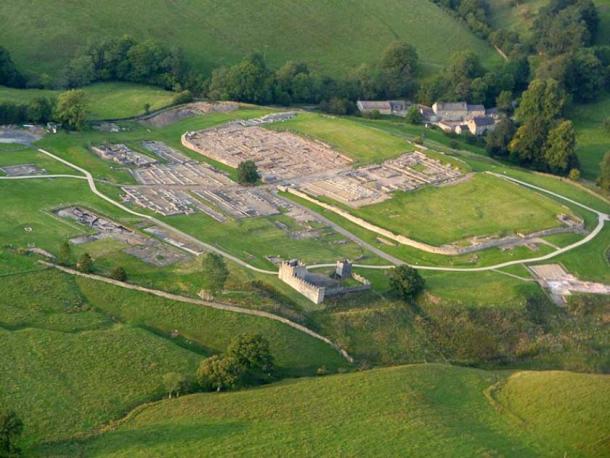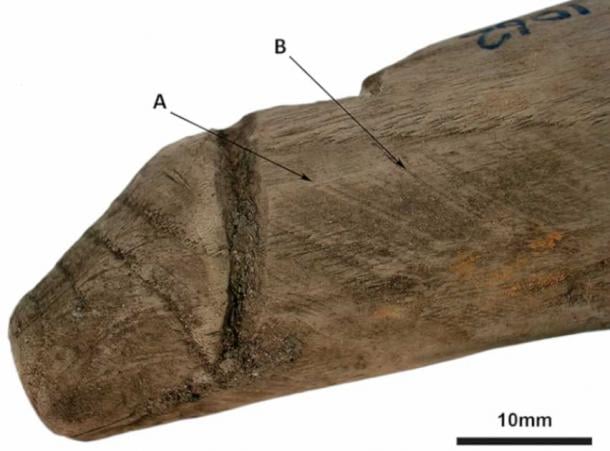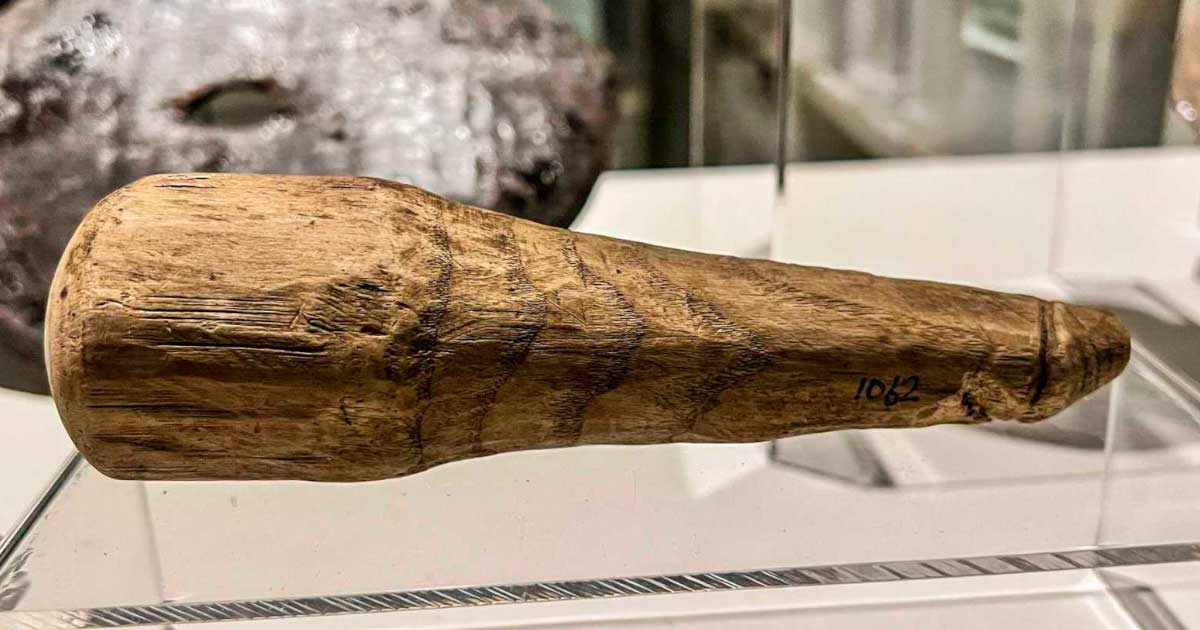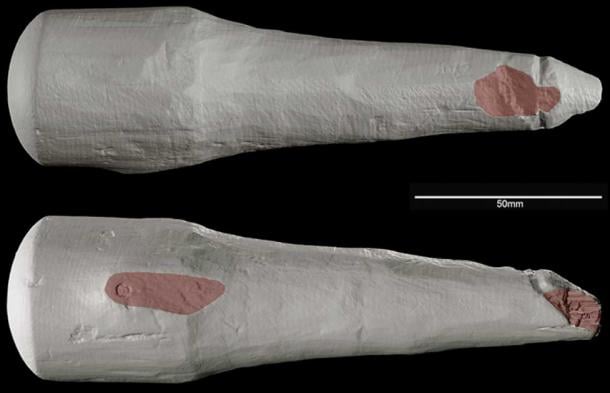2,000-Year-Old Roman Phallus Could Be Oldest Known Sex Toy
In what is perhaps the oldest sex toy ever found in Britain, a 2,000-year-old Roman phallus is the subject of a new study. Found in 1992 near the Roman fort of Vindolanda near Hadrian’s Wall, the northernmost Roman frontier in Britain, it was initially recorded as a darning object, a pestle or a good-luck charm used to “ward off evil.” But now the evidence suggests otherwise.
A recent 3D scan of the object, which measures 6.3 inches (16cm) in length, revealed that both ends had been worn smooth, suggesting that it had been touched repeatedly over time. In trying to resolve the riddle, the researchers explored three possible ways in which the wooden phallus could have been put to use – as a pleasure tool, pestle or even a good luck charm. It’s use as a sex toy came out on top.

Aerial view of Vindolanda, where the wooden “sex toy” was unearthed. (Mike Bishop / CC BY-SA 2.0)
A Discarded Dildo: Was the Vindolanda Phallus Really a Sex Toy?
“The size of the phallus and the fact that it was carved from wood raises a number of questions about its use in antiquity,” said first author Robert Collins, a senior lecturer in the department of archaeology at Newcastle University in England. The study stresses that it was probably used as a sex toy for clitoral stimulation rather than penetration.
- Roman Graffiti Shows Carved Phallus With Insult Found at Vindolanda Fort
- Latest Vindolanda Find: A Strange Naked Man on a Carved Relief Tablet
“We cannot be certain of its intended use, in contrast to most other phallic objects that make symbolic use of that shape for a clear function, like a good luck charm,” explained Collins. “We know that the ancient Romans and Greeks used sexual implements — this object from Vindolanda could be an example of one,” he added. Collins acknowledged that Roman art and literature displayed the use of dildos, but no other archaeological example had been found, until now.
Wooden 'Roman sex toy' found at a Roman fort on Hadrian's Wall https://t.co/KrFlsAC9so
— BBC News (UK) (@BBCNews) February 20, 2023
The phallus is believed to be the “first known example of a non-miniaturized disembodied phallus made of wood in the Roman world.” It was found among several items discarded in a ditch from the second century AD, including shoes, dress accessories, small tools, scraps of leather and worked antlers, which is the reason for its original mislabelling, as per the new study published in the journal Antiquity.
Collins has also been quick to not trivialize this discovery as a “sex toy” used for frivolous pleasures surrounding simple sexual stimulation. In fact, he is conscious that dildos can and have been used as instruments of torture to assert dominance and reinforce power disparities.

Discovered amongst shoes, dress accessories and other tools, the Vindolanda phallus was originally categorized as a darning tool. New analysis that the life-sized phallus may have been a sex toy or Roman dildo. (R. Sands / Antiquity)
The Many Uses of Phallic Objects in the Roman Empire
The Vindolanda phallus was found to have greater wear at both its ends than in the middle. The smoothness at both ends, likely due to repeated gripping and oils from the skin, suggests that the phallus was used as a talisman that could have been inserted into a structure, statue or another object, where it was touched by passers-by for good luck or to gain protection from misfortune. This practice was common throughout the Roman Empire.
The so-called Vindolanda wooden wonder tool could have also been used as a pestle for grinding or mixing materials for cooking, cosmetics, ointments, or medicines. The shape of the phallus could have symbolically added protection or potency to whatever was being prepared, with the act of grinding believed to activate the magic, according to report by The Guardian.
Throughout the Roman Empire, phallic objects were common and served a variety of purposes. They were seen as powerful symbols of fertility, and believed to protect against bad luck or ward off evil spirits. Phalli were depicted in various forms of Roman art, including painted frescoes, mosaics, and sculptures. They were also carved into knife handles and incised into pottery. Small, portable phalli made of bone or metal were often worn as pendants around the neck.
The Romans also used phallic objects for more practical purposes, like the aforementioned pestle for grinding herbs or other materials used in cooking, cosmetics and medicine. The shape of the phallus was thought to add potency to whatever was being prepared. They were even used as tools for darning clothes or weaving baskets.
Phallic objects were also used in various religious and cultural rituals in the Roman Empire. For example, they were often used in the worship of the god Priapus, who was the god of fertility and protector of livestock, fruit plants and gardens. In some areas, phallic objects were carried in processions, and people would touch them for good luck or to gain protection from misfortune.
Areas of damage on the Vindolanda phallus as revealed by 3D scans. (R. Sands / Antiquity)
Rare Wooden “Sex Toy” Arouses Archaeological Attention
So why have phallic objects, particularly from the Roman era, not seen light of day before this? “Wooden objects would have been commonplace in the ancient world, but only survive in very particular conditions – in northern Europe normally in dark, damp and oxygen free deposits,” explained Dr. Rob Sands, Lecturer in Archaeology from the University College Dublin and study co-author.
- The Romans’ Playful Side Revealed By Prank Mouse in Vindolanda
- Archaeologists Uncover Spine-tingling New Hoard of Roman Letters at Vindolanda Fort
Vindolanda is an ancient Roman fort and settlement dating back to the second century AD. It is particularly famous for the Vindolanda Tablets, a collection of wooden writing tablets that were preserved in the wet soil of the site and provide a unique glimpse into the daily lives of the soldiers and civilians who lived at Vindolanda.
The fact that the Vindolanda phallus – be it a dildo, pestle or good luck charm – has been recovered, makes it exceptionally rare and its survival affords a unique glimpse into the personal desires and lifestyles of those who inhabited Vindolanda. “It survived for nearly 2,000 years to be recovered by the Vindolanda Trust because preservation conditions have so far remained stable,” highlighted Sands. “However, climate change and altering water tables mean that the survival of objects like this are under ever increasing threat.”
Top image: The wooden phallus discovered at Vindolanda exhibited smooth surfaces on both ends, suggesting that it had been subject to repeated handling over an extended period. Source: Newcastle University.
By Sahir Pandey
References
BBC. 20 February 2023. “Hadrian's Wall: Wooden 'Roman sex toy' found in Northumberland” in BBC. Available at: https://www.bbc.com/news/uk-england-tyne-64678612
Best, S. 20 February 2023. “Is this Britain's oldest SEX TOY? 6.3 inch-long wooden artefact discovered at Roman Vindolanda may have been used as a 'sexual implement' 2,000 years ago, experts say” in The Daily Mail. Available at: https://www.dailymail.co.uk/sciencetech/article-11763623/6-3in-long-wooden-object-Roman-Vindolanda-used-SEX-TOY-2-000-years-ago.html
Brown, M. 20 February 2023. “It’s not a darning tool, it’s a very naughty toy: Roman dildo found” in The Guardian. Available at: https://www.theguardian.com/science/2023/feb/20/its-not-a-darning-tool-its-a-very-naughty-toy-roman-dildo-found
Collins, R., Sands, R. 20 February 2023. “Touch wood: luck, protection, power or pleasure? A wooden phallus from Vindolanda Roman fort” in Antiquity. Available at: https://doi.org/10.15184/aqy.2023.11
Firtina, N. 20 February 2023. “Ancient sex toy? 2,000-year-old Roman wooden tool likely a dildo” in Interesting Engineering. Available at: https://interestingengineering.com/culture/roman-ancient-sex-toy-wooden-dildo
Orie, A. 20 February 2023. “Wooden object nearly 2,000 years old suggests Romans used sex toys, study says” in CNN. Available at: https://edition.cnn.com/2023/02/20/world/roman-wooden-phallus-sex-object-intl-scli-scn/index.html
Nalewicki, J. 20 February 2023. “Smooth wooden phallus found at a Roman fort was likely a sex toy” in LiveScience. Available at: https://www.livescience.com/smooth-wooden-phallus-found-at-a-roman-fort-was-likely-a-sex-toy.
Location: Newcastle upon Tyne, United Kingdom
Category: News – History & Archaeology, Artifacts – Other Artifacts
Tags: Vindolanda, phallus, sex toy, wooden, dildo, Roman,
Facebook: This 2,000-year-old wooden phallus is causing quite a stir! Found in Britain in the 90s, thanks to modern tech it is now believed to be the oldest sex toy ever discovered.
Keyword: Vindolanda sex toy
Meta Description (160 character): Thought to be the oldest sex toy ever discovered, this 2,000-year-old wooden phallus found in Britain is causing quite a stir.
OneSignal Title (40-50 characters): Roman Phallus is World’s Oldest Sex Toy



















Comments
This is quite clearly a sex toy. It appears to have been used, as it shows wear. I’m glad archaeologists are admitting it was a sex toy and not an implement for “darning,” which is ridiculous.